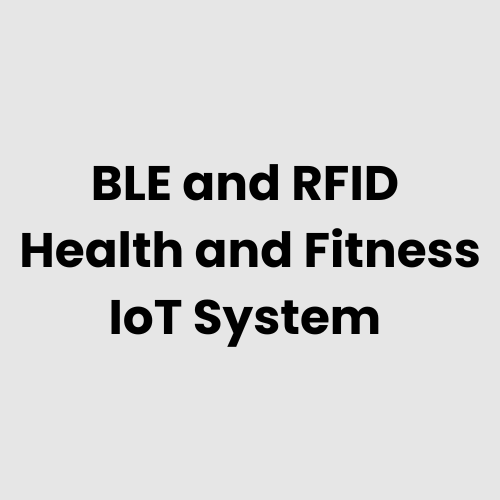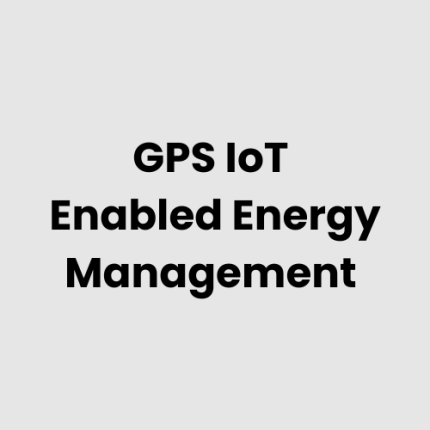Description
Technical Architecture of BLE and RFID IoT Enabled Health and Fitness IoT System
The BLE and RFID IoT Enabled Health and Fitness IoT System by GAO Tek combines cutting-edge technologies to deliver seamless tracking, data collection, and analysis for health and fitness applications.
- Sensors and Devices: BLE-enabled wearables and RFID tags capture physiological and activity data.
- Gateways: BLE hubs collect data from wearables and relay it to local servers or the cloud.
- Data Processing Layer: Real-time data processing enables rapid analytics and feedback loops.
- Cloud Integration: Cloud platforms provide long-term data storage, advanced analytics, and remote monitoring.
- User Interfaces: Mobile apps and web portals offer real-time access to health and fitness metrics.
List of Hardware
- BLE Wearables: Smartwatches, fitness bands, and chest straps.
- RFID Tags: Passive and active RFID tags for equipment and participant tracking.
- BLE Gateways: Devices that collect wearable data and transmit it to local or cloud servers.
- Local Servers: On-premises data storage and processing units.
- Cloud Servers: Scalable, remote infrastructure for data analytics and archival.
- Display Devices: Tablets or kiosks for real-time data visualization.
- Charging Stations: For wearables and other connected devices.
Physical Placement Considerations
- Wearables: Worn on the wrist, chest, or other optimal locations for accurate data collection.
- Gateways: Positioned to ensure maximum BLE range coverage, avoiding signal interference.
- RFID Readers: Strategically installed at entry points or activity zones for effective tag reading.
- Servers: Located in secure, temperature-controlled environments.
- Display Devices: Easily accessible in gyms, fitness centers, or health monitoring stations.
Hardware Architecture
- Wearable Sensors: Generate health and activity data such as heart rate, steps, and calories burned.
- BLE Communication Modules: Transmit data to BLE gateways with low latency.
- RFID Systems: Track equipment usage and participant location in fitness facilities.
- Centralized Processing Unit: Aggregates data for local or cloud processing.
- Visualization Tools: Displays metrics via intuitive dashboards and reports.
Deployment Considerations
- Network Design: Ensure adequate BLE and RFID coverage for uninterrupted data transmission.
- Power Supply: Reliable power sources for gateways and local servers.
- Data Security: Employ encryption for data in transit and at rest to comply with privacy standards.
- User Training: Provide guidance on wearable usage and system interfaces.
- Scalability: Design for future upgrades in user volume or feature expansions.
List of Relevant Industry Standards and Regulations
- ISO/IEC 14443
- Bluetooth SIG Standards
- IEEE 802.15.1
- ISO 9001 for Quality Management
- HIPAA (Health Insurance Portability and Accountability Act)
- GDPR (General Data Protection Regulation)
- FDA Regulations for Health Devices
Local Server Version
For facilities preferring on-premises data management, GAO Tek offers a local server version of the BLE and RFID IoT Enabled Health and Fitness IoT System. The local server version supports:
- Real-Time Processing: Immediate data processing for faster insights.
- Data Privacy: Enhanced security for sensitive health data.
- Custom Analytics: Tailored analysis for specific fitness programs.
Cloud Integration and Data Management
GAO Tek’s system integrates seamlessly with leading cloud platforms, offering:
- Scalable Data Storage: Unlimited capacity for historical data.
- Advanced Analytics: Machine learning-driven insights into user health and fitness trends.
- Remote Monitoring: Access system metrics from anywhere via secure web portals.
- Data Interoperability: Integration with third-party health applications and platforms.
GAO Tek’s extensive experience ensures smooth deployment and support for all components of the BLE and RFID IoT Enabled Health and Fitness IoT System. Visit GAO Tek Inc. for more information.
GAO Case Studies of BLE and RFID IoT Enabled Health and Fitness IoT System
USA Case Studies
- San Francisco, CA
A leading gym chain implemented BLE wearables and RFID tracking to monitor member activity and optimize equipment usage. The system provided real-time insights into fitness patterns, enhancing member satisfaction and equipment efficiency. - New York City, NY
A corporate wellness program deployed BLE fitness trackers to encourage employee engagement. Data collected was securely processed on local servers, enabling tailored fitness recommendations. - Austin, TX
A fitness center utilized BLE and RFID solutions to manage client attendance and provide personalized training plans. Automated data collection reduced administrative workload and improved service quality, aligning with IEEE standards. - Chicago, IL
A health club introduced BLE-enabled wearables for monitoring workout intensity and RFID for locker access. The implementation followed ISO/IEC 18000-63 standards, ensuring compatibility and data security. - Seattle, WA
A university gym incorporated BLE wearables for students to track fitness goals. RFID-based entry systems streamlined access, compliant with ANSI/BICSI standards. - Miami, FL
A wellness retreat employed BLE devices to monitor participant vitals during activities. The data was securely integrated into cloud platforms for advanced analytics and reporting. - Los Angeles, CA
A public fitness initiative used BLE and RFID to track participants’ performance across outdoor activities, leveraging FCC-certified devices. - Boston, MA
A health research center adopted BLE-enabled wearables to collect longitudinal health data from participants. The RFID-based identification system streamlined participant management while ensuring adherence to HIPAA regulations. - Denver, CO
A gym implemented BLE wearables for real-time performance tracking and RFID for contactless payments. This deployment was guided by PCI DSS compliance. - Houston, TX
A sports complex used BLE wearables to monitor athletes’ vitals and RFID to manage equipment inventory, meeting ISO 9001 quality management standards. - Phoenix, AZ
A medical fitness facility utilized BLE technology to monitor cardiac rehabilitation patients. RFID tags managed secure patient access, aligning with FDA guidelines. - Atlanta, GA
A corporate gym installed BLE-based wearables for employee health monitoring and RFID for asset tracking, ensuring compliance with OSHA standards. - Dallas, TX
A community center deployed BLE wearables for personalized fitness plans. RFID-enabled badges improved access control and member safety, meeting NIST cybersecurity standards. - Orlando, FL
A sports science lab adopted BLE wearables for performance analytics and RFID for athlete identification. Integration with IEEE IoT standards enhanced system reliability. - Portland, OR
A boutique gym chain implemented BLE trackers to analyze customer engagement and RFID lockers for secure storage, following CSA Group standards.
Canada Case Studies
- Toronto, ON
A wellness startup used BLE wearables for real-time health data tracking. RFID systems enabled seamless gym access, compliant with Canadian Privacy Laws. - Vancouver, BC
A recreational sports league utilized BLE devices for player health tracking and RFID badges for automated registration, adhering to Industry Canada regulations.
Navigation Menu for BLE and RFID IoT
Navigation Menu for IoT
- LORAWAN
- Wi-Fi HaLow
- Z-WAVE
- BLE & RFID
- NB-IOT
- CELLULAR IOT
- GPS IOT
- IOT SENSORS
- EDGE COMPUTING
- IOT SYSTEMS
Our products are in stock and can be shipped to anywhere in continental U.S. or Canada from our local warehouse. To purchase or for any further information, please fill out this form or email us.
We are actively looking for partners who are like us located in the U.S. and Canada. For more information on partnering with GAO, please visit Partner with GAO Tek Inc. It lists various ways to partner with GAO, such as OEM Partnerships, Technology Integration, Distribution and Reselling Opportunities, Presenting at the Leading Event Tek Summit, Joint R&D Projects, Training and Consulting Services, Industry-Specific Collaborations, Research and Academic Partnerships.



